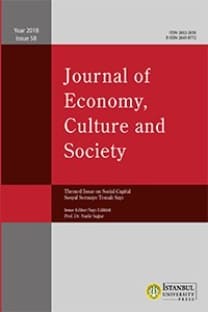Görme Özürlü Çocukların Geleceğe İlişkin Düşüncelerinde Ailelerinin Sosyo-Ekonomik Düzeyinin Önemi: Ankara Örneği
Anahtar Kelimeler:
-
___
- Bower, B., (2001), "Disability Develop as Family Affair", Science News, 160(18),p276,l-2 p.
- Burcu, E. (2002), "Üniversitede Okuyan Özürlü Öğrencilerin Sorunları:Hacettepe-Beytepe Kampüsü Öğrencileri Örneği", H.Ü Edebiyat Fakültesi Dergisi, cilt: 19, sayı: 1, ss.83-103.
- Burcu, E. (2001), "Gençlik ve İntihar İlişkisi Çerçevesinde Özürlü Olma: Bir Grup Özürlü Üniversite Öğrencisinin İntihar Hakkındaki Düşünceleri", Polis Bilimleri Dergisi, 3(3-4), ss. 13-38.
- Demarle, D.J. ve P. Le Roux (2001), "The Life Cycle And Disability:Experiences of Discontinuity in Child and Family Development", Journal of Loss&Trauma, 6:29-43.
- Dobson, B., S.Middleton ve A.Beardsworth (1998), "The Impact of Childhood Disability on Family Life", 77;e Second Report by Joseph Rowntree Foundation YorleYPS for the Joseph Rowntree Foundation.
- Dowling, M . , L.Dolan (2001), "Families with Children with Disabilities-Inequalities and Social Model", Disability&Society, 16(1).
- Helander, E. (1993), "Prejudice and Dignity:An Introduction to Community-based Rehabilitation", United Nations development Program, Report No:E93-111 B.3,. New York: UNDP.
- McCubbin, H . I . , E.A. Thompson, A . I . Thompson, M.A.McCubbin ve A.J.Kaston (1993), "Culture, ethnicity, and the Family:Critical Factors in Childhood Chronic Illness and Disability", Pediatrics, 91 (5),pl 063(8).
- Morse, J.M, S.Wilson, J.Penrod (2000), "Mothers and Their Disabled ChildremRefining the Concept of Normalization", Health Care for Women International, 21 (8), p669, 18p, 1- chart.
- Murphy, A.T. (1979), "The Families of Handicapped ChildremContext for Disability", Volta Review, 81 (5),p256-78.
- Özürlüler Şurası (I.) (1999), "Çağdaş Toplum Yaşamı ve Özürlüler Komisyon Raporları Genel Kurul Görüşmeleri", Ankara:TC.N.Ö.İ.B.
- Park, J. ve A.P.Turnbull (2002), "Impacts of Poverty on Quality of Life in Families of Children with Disabilities", Exceptional Children, 68(2), pp.l51-20p.
- Philip, M . ve D. Duckworth (1982), "Children with Disabilities and Their Families:A Review of Research", Paper for the OECD Project, The Handicapped Adolescent Windors, Berks:NFER-Nelson.
- Socio-Economic Disadvantage and Prevalence of Disability (2000), Final Report, For the Victorian Department of Human Services, Disability Services, Social Policy Research Center, University o f New South Wales.
- Straus, A . (1989). Family Training in Crime and Violence. In A. Straus (ed.). Crime and the Family. IlIinois:C.Thomas Pub.
- Wells, E. L. ve Rankin J. H . (1991). Families and Delinquency: A Meta-Analysis of the Impact of Broken Homes. Social Problems, X X X V I I I , 1 ,71-93.
- Whyte S.R. ve B. Ingstad (1995), "Disability and Culture:An Overview", S.R.Whyte ve B. Ingstad (eds), Disability and Culture, California:University of California Press.
- ISSN: 2602-2656
- Yayın Aralığı: Yılda 2 Sayı
- Başlangıç: 1960
- Yayıncı: İstanbul Üniversitesi Yayınevi
Sayıdaki Diğer Makaleler
21. Yüzyılda Esnek Çalışma Biçimleri ve Toplumların İş Hayatına Uygulanması
Ölümünün 30. Yılında Hocamız Ord. Prof. Dr. Ziyaeddin Fahri Fındıkoğlu
Türkiye'nin Türk Dünyasındaki Eğitim-Öğretim Faaliyetleri
İletişim, Çevre Etkileşimi ve Ulusal Mensubiyet Bilincinin Algılanması
Temel İş-Güç Biçimi Değişiminin Yaşam Tarzı Üzerindeki Etkileri: Afyon-Sandıklı Örneği
Arş. Gör. Dr. Serkan GÜZEL, Prof. Dr. Gülay ARIKAN
Üniversite Öğrencilerinin 2002 Dünya Kupasına Katılan Ülkelere Yönelik Tutum ve Önyargıları
Türkiye'de Üniversite-Sanayi İlişkileri ve Kobi'ler (Küçük Sanayi) Açısından Önemi
Reşat Nuri Güntekin'in "Yaprak Dökümü" Adlı Romanında Değişmenin Sosyo-Kültürel Boyutları
